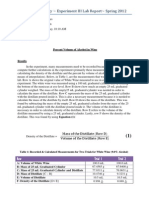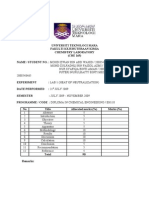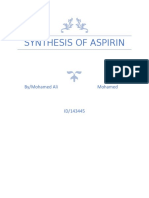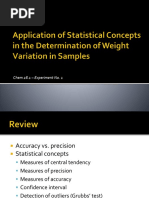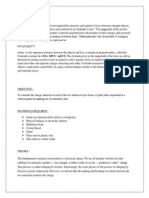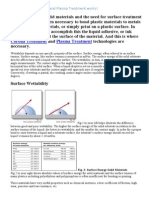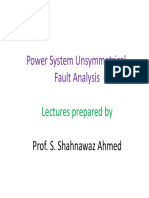Laboratory Report #2 (Molar Mass of A Volatile Liquid)
Laboratory Report #2 (Molar Mass of A Volatile Liquid)
Uploaded by
Immanuel De Los ReyesCopyright:
Available Formats
Laboratory Report #2 (Molar Mass of A Volatile Liquid)
Laboratory Report #2 (Molar Mass of A Volatile Liquid)
Uploaded by
Immanuel De Los ReyesOriginal Description:
Original Title
Copyright
Available Formats
Share this document
Did you find this document useful?
Is this content inappropriate?
Copyright:
Available Formats
Laboratory Report #2 (Molar Mass of A Volatile Liquid)
Laboratory Report #2 (Molar Mass of A Volatile Liquid)
Uploaded by
Immanuel De Los ReyesCopyright:
Available Formats
CM011L: CHEMISTRY FOR ENGINEERS (LABORATORY)
1ST Quarter SY 2018-2019
Molar Mass of Volatile Liquid (Experiment 02)
Manguiam, Von Louie R.1, Delos Reyes, Immanuel, T.2
1Professor, School of Chemical, Biological, and Materials Engineering and Sciences, Mapúa University; 2Student, CM011L/A9, Mapúa University
ABSTRACT
A volatile liquid are liquids that vaporize easily and does have a boiling point. The Dumas method was primarily used for an
accurate determination of molar mass. The ideal gas law became the basis of Dumas method to determine the molecular weight
by using the formula PV=nRT. The objective of this experiment is to measure the physical properties of pressure, volume, and
temperature for a gaseous substance by using the ideal gas law and determine the molar mass (molecular weight) of a volatile
liquid. Using a barometer, the pressure of the of the Erlenmeyer flask was identified. Boiling chips was placed on the flask to
prevent water from overheating with foil and rubber band attached to the flask. Thermometer was used to record the temperature
of the boiling water inside the flask. After the vaporization the left water on the flask was put on a graduated cylinder to identify
how much volume was vaporized from the original amount of volume. By this you can determined the molar mass and moles of
vapor by using Ideal gas law. After doing the experiment, moles of vapor was calculated using PV=nRT. The mass of the vapor
was calculated by subtracting the before and after weights of the flask and molar mass of the vapor can be determined. This
experiment will help students to give them further knowledge on how to determine a molar mass of volatile liquid which helps to
analysed certain amount of chemical in a physical of a substance.
Keywords: Molar mass, ideal gas law, volatile liquid, dumas method, compound
INTRODUCTION
A volatile liquid are liquids that vaporize easily and researchers weigh the Erlenmeyer flask with aluminium foil
does have a boiling point. Molar mass is a property which and rubber band attached by using digital weighing scale.
helps us to distinguish the molar mass of the volatile liquid Then put the flask into the iron stand with wire gauze and
beaker. A three hundred (300) ml of tap water was put on the
(Isopropyl alcohol). A technique to know the molecular mass
beaker then submerged the flask into the beaker with water
is by using the ideal gas law, PV=nRT where p is the
and boiling chips. Next, the researchers put the volatile liquid
pressure, V is the volume, n is the amount of substance, R (isopropyl alcohol) by injecting it using a syringe. Then they
is the gas constant, and T is the temperature which is the started to boil it by using the Bunsen burner and wait until
basis for the dumas method. An ideal gas is a hypothetical there are bubbles signifying is boiling. After boiling they
gas dreamed by chemists and students because it would be waited for at least thirty (30) seconds to cool it down and
much easier if things like intermolecular forces (Laugier, measure the mass of the Erlenmeyer flask. Once they got
2007). the mass they measured the atmospheric pressure using a
barometer. Lastly, they used the obtained atmospheric
The purpose of this experiment is to measure the pressure to find the volume of the Erlenmeyer flask after
physical properties of pressure, volume and temperature for dumping it inside the beaker.
gaseous substance by using the Ideal gas law and also to
determine the molar mass molecular weight of volatile liquid RESULTS AND DISCUSSION
which is an Isopropyl alcohol
In this experiment, Ideal gas law was used to
MATERIALS AND METHODS determine the molecular mass of the compounds.
Materials used in the experiment are; Erlenmeyer PV=nRT
flask, Beaker, Iron clamp, iron stand, wire gauze, Bunsen
burner, matches, barometer and isopropyl alcohol. First, the
Experiment 01│ Group No.│ Date of Experiment 1 of 3
CM011L: CHEMISTRY FOR ENGINEERS (LABORATORY)
1ST Quarter SY 2018-2019
Table 1. Preparing the sample
Setup Trial
Mass of dry flask, foil, and rubber
85.57g
band (g)
The group measured the Erlenmeyer flask in a
digital weighting scaled that given us a result of 85.88g.
Table 2. Vaporize the sample
Setup Trial
Temperature of boiling water 93°C. 366.15K
Mass of dry flask, foil, rubber
85.88g
band, and vapor
The temperature measured using a thermometer
on the beaker was 93 °C which is equal to 366.15 K and
Figure 1.1. Volatile Liquid (Isopropyl alcohol) the obtained mass of the dry flask, foil, rubber band and
vapor was 85.88g.
Table 3. Determine the Volume and Pressure of the Vapor
Setup Trial
Volume of 125-mL flask(L) 167 mL = 0.167 L
Atmospheric pressure (torr, atm) 756 torr, 0.995 atm
The data that was collected by computing the total
volume which was 0.50 mL + 0.50 mL + 0.50 mL + 0.17 mL
which resulted to 167 mL converted to L gives 0.167 L. The
group got a 756 torr which can be converted to 0.995 atm.
Table 4. Calculations
Setup Trial
Moles of vapor, n(vapor)[mol] 0.0055 mol
Mass of vapor, m(vapor)[g] 0.32g
Molar mass of compound (g/mol) 56.36 g/mol
Figure 1.2. Injecting of volatile liquid to water Average molar mass (g/mol) 56.36 g/mol
The obtained calculations for the moles of vapor
was determined using the ideal gas law PV=nRT that
resulted to 0.0055 mol of vapor and by subtracting the before
and after mass of flask gives a 0.32 g difference. Lastly, the
molar mass of the compound and average molar mass is the
same which is 56.36 g/mol.
CONCLUSIONS AND RECOMMENDATION
In conclusion, the average molar mass was 56.36
g/mol. During the experiment we encountered some errors in
the experiment especially on the boiling of the Erlenmeyer
flask that we didn’t notice if the flask is boiling already so got
a ninety-three (93) degrees Celsius instead of temperature
Figure 1.3. Boiling of water with volatile liquid nearer to the boiling point which is one hundred (100)
Experiment 01│ Group No.│ Date of Experiment 2 of 3
CM011L: CHEMISTRY FOR ENGINEERS (LABORATORY)
1ST Quarter SY 2018-2019
degrees Celsius. Take time on boiling of the flask it’s much
better if large bubbles come to know that the water is in its
boiling point.
REFERENCES
Laugier, A.G., (2007). Derivation of the Ideal Gas
Law. Journal of Chemical Education. 2007, Vol. 84, Iss. 11,
pgs. 1832 -1833.
Levine, S. T., (2003) Derivation of the Ideal Gas
Law. Journal of Chemical Education.1985, Vol. 62, Iss. 5,
pgs. 399.
Experiment 01│ Group No.│ Date of Experiment 3 of 3
You might also like
- Recrystallization of Acetanilide Organic ChemistryDocument6 pagesRecrystallization of Acetanilide Organic ChemistryBangkit Putra SagaraNo ratings yet
- EXPERIMENT CalorimeterDocument15 pagesEXPERIMENT CalorimeterFath BondNo ratings yet
- FINAL LAB Report (Experiment 2)Document40 pagesFINAL LAB Report (Experiment 2)Jonelou CusipagNo ratings yet
- CHEM 1201L Reportsheet For Experiment 2 Gravimetry-1Document5 pagesCHEM 1201L Reportsheet For Experiment 2 Gravimetry-1Jay Meng JusgadoNo ratings yet
- Formal Lab ReportDocument4 pagesFormal Lab ReportBren SisonNo ratings yet
- Chem. 14.1 - Expt. 9 Chem Lab Report - Chemical EquilibriumDocument3 pagesChem. 14.1 - Expt. 9 Chem Lab Report - Chemical EquilibriumRomi Necq S. Abuel40% (5)
- Want Chemistry Games, Drills, Tests and More? You Need To Become An !Document18 pagesWant Chemistry Games, Drills, Tests and More? You Need To Become An !Liezl ValienteNo ratings yet
- Experiment 1 - Density of Liquids Using Westphal BalanceDocument3 pagesExperiment 1 - Density of Liquids Using Westphal BalanceRussea Evangelista100% (1)
- Cryoscopic Method of Molecular Mass Determination: ChemicalDocument10 pagesCryoscopic Method of Molecular Mass Determination: ChemicalKrizzi Dizon Garcia0% (1)
- EXPERIMENT NO 2 Separation of An Organic Mixture, Re Crystallization and Melting Point DeterminationDocument7 pagesEXPERIMENT NO 2 Separation of An Organic Mixture, Re Crystallization and Melting Point DeterminationJanina Nemis100% (1)
- Experiment III Lab Report (Alcohol in Wine)Document6 pagesExperiment III Lab Report (Alcohol in Wine)Clayton VerBerkmös50% (2)
- Lab Report DETERMINATION OF THE CONCENTRATION OF ACETIC ACID IN VINEGARDocument27 pagesLab Report DETERMINATION OF THE CONCENTRATION OF ACETIC ACID IN VINEGARمحمد ازوادي100% (1)
- LAB REPORT - Determination of Concentration Acetic Acid in VinegarDocument12 pagesLAB REPORT - Determination of Concentration Acetic Acid in Vinegarhisham100% (4)
- Chemical Kinetics (Abstract & R&D)Document3 pagesChemical Kinetics (Abstract & R&D)chrxn_17100% (2)
- Chem 17 Formal ReportDocument5 pagesChem 17 Formal ReportPatricia Frances P. FloresNo ratings yet
- Final Report Format (EXP1)Document6 pagesFinal Report Format (EXP1)elbronNo ratings yet
- Lab Report Experiment 2Document19 pagesLab Report Experiment 2Terry DecatoriaNo ratings yet
- Determination of The Molar Mass of A Volatile LiquidDocument3 pagesDetermination of The Molar Mass of A Volatile LiquidMarybeth HopeNo ratings yet
- Exp 3 Formal Lab ReportDocument3 pagesExp 3 Formal Lab ReportRomulo Vincent Perez100% (1)
- Lab Report Heat of ReactionDocument8 pagesLab Report Heat of ReactionLera May BenavidezNo ratings yet
- Anachem NotesDocument10 pagesAnachem NotesAngelaNo ratings yet
- Lab Report 1 (Che165)Document13 pagesLab Report 1 (Che165)Hazim Nahar0% (1)
- Worksheet 4 Combustion of Gas and Liquid FuelDocument3 pagesWorksheet 4 Combustion of Gas and Liquid FuelLin Xian XingNo ratings yet
- Lab Report Acid in VinegarDocument18 pagesLab Report Acid in VinegarAmirah Nadia Mat Lias89% (19)
- Calorimetry Worksheet SolutionsDocument3 pagesCalorimetry Worksheet SolutionsLee Lhouine Kaidz II LirazanNo ratings yet
- Experiment 6 Results and Discussion Report: Determination of The Solubility Product Constant of Calcium HydroxideDocument2 pagesExperiment 6 Results and Discussion Report: Determination of The Solubility Product Constant of Calcium HydroxideNathalie Dagmang75% (4)
- Lab Report 1 CMT659 Determination of Adsorption Isotherm of Acetic Acid On Activated CharcoalDocument7 pagesLab Report 1 CMT659 Determination of Adsorption Isotherm of Acetic Acid On Activated Charcoallina kwikNo ratings yet
- Triiodide Ion: Determination of An Equilibrium ConstantDocument5 pagesTriiodide Ion: Determination of An Equilibrium ConstantJericho LakampuengaNo ratings yet
- Chapter 1 Lab ReportDocument5 pagesChapter 1 Lab ReportJabin Sta. TeresaNo ratings yet
- Lab Rep 5 Chem 33Document7 pagesLab Rep 5 Chem 33Jazer John Tacda LirazanNo ratings yet
- Determinate of The Concentration of Acetic Acid in VinegarDocument22 pagesDeterminate of The Concentration of Acetic Acid in VinegarSYahira HAzwaniNo ratings yet
- Chem 137.1 - Exer 1 PostlabDocument15 pagesChem 137.1 - Exer 1 PostlabGerry Mark Gubantes100% (1)
- Chemical Equilibrium in A Liquid PhaseDocument7 pagesChemical Equilibrium in A Liquid PhasePevie Anne Tenebroso100% (2)
- Answer 2Document31 pagesAnswer 2petitNo ratings yet
- Topic 5 Volumetry 1col EdJVS - 2019 - 19prob For LecDocument15 pagesTopic 5 Volumetry 1col EdJVS - 2019 - 19prob For LecMarloie MenchavezNo ratings yet
- EXP 4 Surface TensionDocument7 pagesEXP 4 Surface TensionGrace Aquino100% (1)
- Chem 26.1 Lab Manual 2017 Edition (2019) PDFDocument63 pagesChem 26.1 Lab Manual 2017 Edition (2019) PDFBea JacintoNo ratings yet
- Burette CorrectionDocument5 pagesBurette CorrectionLetitia Sarah100% (1)
- Clean Water Identification: Determining Dissolved Oxygen Utilizing Winkler's MethodDocument9 pagesClean Water Identification: Determining Dissolved Oxygen Utilizing Winkler's MethodKyra CastroNo ratings yet
- Experiment 11 Results and Discussion Report: Potentiometric Determination of The Purity and Dissociation Constant of Potassium Hydrogen PhthalateDocument4 pagesExperiment 11 Results and Discussion Report: Potentiometric Determination of The Purity and Dissociation Constant of Potassium Hydrogen PhthalateNathalie Dagmang80% (10)
- Asprin Lab ReportDocument10 pagesAsprin Lab ReportMohamedNo ratings yet
- Calibration of Volumetric Glassware Formal ReportsDocument11 pagesCalibration of Volumetric Glassware Formal ReportsDCRUZ100% (2)
- EXERCISE 7 - Dissolved Oxygen Determination 2Document5 pagesEXERCISE 7 - Dissolved Oxygen Determination 2Kat DinoNo ratings yet
- AnChem Gravimetric CalculationsDocument3 pagesAnChem Gravimetric CalculationsJemarey de RamaNo ratings yet
- Determination of Vapor Density and Molecular Weight of Acetone Using Victor Meyer MethodDocument7 pagesDetermination of Vapor Density and Molecular Weight of Acetone Using Victor Meyer MethodKyle Delos Santos100% (5)
- Oxidation Reduction Titration Lab ReportDocument9 pagesOxidation Reduction Titration Lab ReportTanebi0% (3)
- Complexometric Determination of Water Hardness Lab ReportDocument5 pagesComplexometric Determination of Water Hardness Lab ReportMichelle50% (2)
- CHEM181-M15 Expt. No. 4 FINAL REPORT - MENDOZADocument5 pagesCHEM181-M15 Expt. No. 4 FINAL REPORT - MENDOZAAdrian MendozaNo ratings yet
- Chem 16 3rd Long Exam ReviewerDocument3 pagesChem 16 3rd Long Exam Reviewerggwp21No ratings yet
- Chem 28.1 Post Lab Discussion E1 E5E7Document79 pagesChem 28.1 Post Lab Discussion E1 E5E7Jessabelle IbañezNo ratings yet
- Experiment 3 Lab ReportDocument10 pagesExperiment 3 Lab ReportVanessa Denise AguilarNo ratings yet
- Cryoscopic Determination of Molar MassDocument15 pagesCryoscopic Determination of Molar MassFrances PaulineNo ratings yet
- Exercise 1 Answer To Quide QuestionsDocument3 pagesExercise 1 Answer To Quide QuestionsrickyNo ratings yet
- Group 3 - Laboratory Report 2 - Methane and Its PropertiesDocument22 pagesGroup 3 - Laboratory Report 2 - Methane and Its PropertiesJESSIE FREDRICK DALANIELNo ratings yet
- Analiticka Prasanja Od ScribdDocument37 pagesAnaliticka Prasanja Od ScribdDoe BlackNo ratings yet
- Determination of Chloride by Volhard and Mohr MethodDocument6 pagesDetermination of Chloride by Volhard and Mohr MethodShane AmolarNo ratings yet
- Determination of DensitiesDocument3 pagesDetermination of DensitiesLouie Jay BallenasNo ratings yet
- 170 Experiment 1Document6 pages170 Experiment 1jestineNo ratings yet
- Molar Mass of A Volatile LiquidDocument16 pagesMolar Mass of A Volatile LiquidJoaquin MoulicNo ratings yet
- Lab Report Exp 2Document8 pagesLab Report Exp 2Mau TenNo ratings yet
- The DifferentialsDocument23 pagesThe DifferentialsImmanuel De Los ReyesNo ratings yet
- Trigonometric FunctionDocument18 pagesTrigonometric FunctionImmanuel De Los ReyesNo ratings yet
- Indeterminate Forms PDFDocument23 pagesIndeterminate Forms PDFImmanuel De Los ReyesNo ratings yet
- Indeterminate FormsDocument23 pagesIndeterminate FormsImmanuel De Los ReyesNo ratings yet
- Derivatives of Hyperbolic FunctionsDocument11 pagesDerivatives of Hyperbolic FunctionsImmanuel De Los ReyesNo ratings yet
- GEC223 - The Boundary Layer Is A Consequence of The Stickiness of The FluidDocument12 pagesGEC223 - The Boundary Layer Is A Consequence of The Stickiness of The FluidMawada RashedNo ratings yet
- Analysis of The Effect of Counter-Cone Location On Cyclone SeparatorDocument12 pagesAnalysis of The Effect of Counter-Cone Location On Cyclone SeparatorAnonymous NxpnI6jCNo ratings yet
- Antenna Basics PDFDocument82 pagesAntenna Basics PDFSabbir Ahmed100% (1)
- WWW - Manaresults.Co - In: (Common To ME, AME, MSNT)Document2 pagesWWW - Manaresults.Co - In: (Common To ME, AME, MSNT)Asheesh KumarNo ratings yet
- Combined CyclesDocument17 pagesCombined CyclesMuhammad HarisNo ratings yet
- Chapter FourDocument42 pagesChapter FourHaitham AyyadNo ratings yet
- Reactor & PID SlidesDocument11 pagesReactor & PID SlidesDg Nurzillah Ag KacheeNo ratings yet
- Physics Project On Pith BallsDocument8 pagesPhysics Project On Pith BallsAmritesh Mishra50% (4)
- Ex 03Document2 pagesEx 03Zeynep CihanNo ratings yet
- Finite Wings: Kelvin's TheoremDocument10 pagesFinite Wings: Kelvin's Theoremkyoko72No ratings yet
- 1) Explain The Diffusion of Bromine Particles Throughout The Two Gas JarDocument16 pages1) Explain The Diffusion of Bromine Particles Throughout The Two Gas JarLee Li JieNo ratings yet
- Distributed Power Flow Controler (DPFC)Document44 pagesDistributed Power Flow Controler (DPFC)rajesh_d84No ratings yet
- How Corona Treatment and Plasma Treatment WorksDocument9 pagesHow Corona Treatment and Plasma Treatment WorksDragan NedicNo ratings yet
- The MCAT Physics BookDocument445 pagesThe MCAT Physics Bookichephren77% (13)
- NOUN 2019 2 POP Final Exam TimetableDocument18 pagesNOUN 2019 2 POP Final Exam TimetableAlade AyodeleNo ratings yet
- Nuclear Physics Lab-2022 2Document3 pagesNuclear Physics Lab-2022 2MySunNo ratings yet
- Quantum Spin Liquids - Review - RMP2017Document50 pagesQuantum Spin Liquids - Review - RMP2017Shengwei2 EmmaNo ratings yet
- En 310-1993-EnDocument9 pagesEn 310-1993-EnxyzhynNo ratings yet
- Home Assignment Class 10 (Physics)Document5 pagesHome Assignment Class 10 (Physics)Theboss SharmaNo ratings yet
- Tutorial 2 Integration by Parts, Trigo Integrals, Inverse Trigo and Partial FractionsDocument6 pagesTutorial 2 Integration by Parts, Trigo Integrals, Inverse Trigo and Partial FractionsAinnur SyabihaNo ratings yet
- MO CIA 1 Set 1 23-24Document2 pagesMO CIA 1 Set 1 23-24arumugam gopalNo ratings yet
- Biophysical Labeling Methods in Molecular Biology (2005)Document320 pagesBiophysical Labeling Methods in Molecular Biology (2005)Nivia FerrisNo ratings yet
- St. Martin'S Engineering College: Tutorial Question BankDocument11 pagesSt. Martin'S Engineering College: Tutorial Question Bankxb1f30No ratings yet
- Radio Waves: Disadvantage of Radio WaveDocument2 pagesRadio Waves: Disadvantage of Radio WaveEricka Pallon CamayudoNo ratings yet
- Power Factor Improvement Panel (PFIP) : Electrical - Economic - EfficientDocument3 pagesPower Factor Improvement Panel (PFIP) : Electrical - Economic - EfficientAhmad Salman MustafaNo ratings yet
- Engineering Physics Module - 1Document13 pagesEngineering Physics Module - 1G46Anand P KNo ratings yet
- (MATH1013) (2016) (F) Midterm Wsuab 41338Document9 pages(MATH1013) (2016) (F) Midterm Wsuab 41338陳希程No ratings yet
- Electrical SystemDocument75 pagesElectrical SystemS Bharadwaj Reddy75% (4)
- Unsymmetrical Fault AnalysisDocument49 pagesUnsymmetrical Fault AnalysisabdulbabulNo ratings yet










